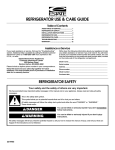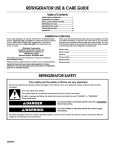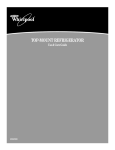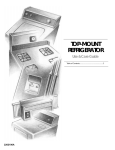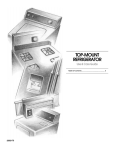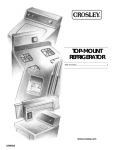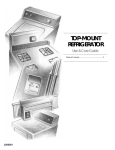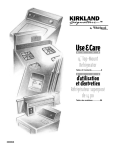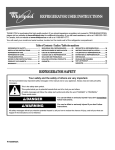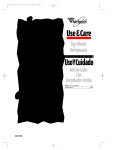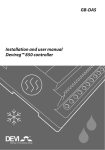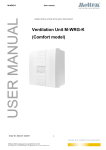Download Whirlpool WRT111SFAF Owner`s manual
Transcript
Do Not Throw Away — additional important safety information included. INSTALLATION INSTRUCTIONS AND OWNER’S MANUAL TOP MOUNT REFRIGERATOR Table of Contents REFRIGERATOR SAFETY..................................................................... 2 Proper Disposal of Your Old Refrigerator........................................... 2 INSTALLATION INSTRUCTIONS ......................................................... 3 Unpack the Refrigerator...................................................................... 3 Location Requirements....................................................................... 3 Electrical Requirements ...................................................................... 4 Water Supply Requirements............................................................... 4 Connect the Water Supply.................................................................. 4 Refrigerator Doors............................................................................... 5 Adjust the Doors ................................................................................. 8 REFRIGERATOR FEATURES ............................................................... 8 Refrigerator Shelves............................................................................ 8 Meat Drawer........................................................................................ 8 Crisper................................................................................................. 9 Utility or Egg Bin ................................................................................. 9 FREEZER FEATURES ........................................................................... 9 Freezer Shelf ....................................................................................... 9 DOOR FEATURES ............................................................................... 10 Door Rails or Trivets.......................................................................... 10 Can Racks and Door Bins ................................................................ 10 Vacation and Moving Care ............................................................... 10 PROBLEM SOLVER............................................................................. 11 W10475403A REFRIGERATOR SAFETY Your safety and the safety of others are very important. We have provided many important safety messages in this manual and on your appliance. Always read and obey all safety messages. This is the safety alert symbol. This symbol alerts you to potential hazards that can kill or hurt you and others. All safety messages will follow the safety alert symbol and either the word “DANGER” or “WARNING.” These words mean: You can be killed or seriously injured if you don't immediately follow instructions. DANGER You can be killed or seriously injured if you don't follow instructions. WARNING All safety messages will tell you what the potential hazard is, tell you how to reduce the chance of injury, and tell you what can happen if the instructions are not followed. IMPORTANT SAFETY INSTRUCTIONS WARNING: To reduce the risk of fire, electric shock, or injury to persons when using the refrigerator, follow basic precautions, including the following: ■ ■ ■ ■ ■ ■ ■ Plug into a grounded 3 prong outlet. Do not remove ground prong. Do not use an adapter. Do not use an extension cord. Disconnect power before servicing. Replace all parts and panels before operating. Remove doors from your old refrigerator. ■ ■ ■ ■ Use nonflammable cleaner. Keep flammable materials and vapors, such as gasoline, away from refrigerator. Use two or more people to move and install refrigerator. Disconnect power before installing ice maker (on ice maker kit ready models only). SAVE THESE INSTRUCTIONS State of California Proposition 65 Warnings: WARNING: This product contains one or more chemicals known to the State of California to cause cancer. WARNING: This product contains one or more chemicals known to the State of California to cause birth defects or other reproductive harm. Proper Disposal of Your Old Refrigerator WARNING Suffocation Hazard Remove doors from your old refrigerator. Failure to do so can result in death or brain damage. IMPORTANT: Child entrapment and suffocation are not problems of the past. Junked or abandoned refrigerators are still dangerous – even if they will sit for “just a few days.” If you are getting rid of your old refrigerator, please follow these instructions to help prevent accidents. Before You Throw Away Your Old Refrigerator or Freezer: ■ Take off the doors. ■ Leave the shelves in place so that children may not easily climb inside. 2 Important information to know about disposal of refrigerants: Dispose of refrigerator in accordance with Federal and Local regulations. Refrigerants must be evacuated by a licensed, EPA certified refrigerant technician in accordance with established procedures. INSTALLATION INSTRUCTIONS Unpack the Refrigerator WARNING Location Requirements WARNING Excessive Weight Hazard Use two or more people to move and install refrigerator. Failure to do so can result in back or other injury. Explosion Hazard Remove the Packaging IMPORTANT: Do not remove the white foam air return insert from behind the control panel on the ceiling of the refrigerator. If the insert is removed, ice may migrate down from the freezer and cause icicles to form. 1. Using two or more people, tilt the refrigerator to one side. Remove the screws fastening the plastic runner to the bottom of the refrigerator. Repeat to remove the runner from the opposite side. 2. Remove tape and glue residue from surfaces before turning on the refrigerator. Rub a small amount of liquid dish soap over the adhesive with your fingers. Rinse with warm water and dry with a soft cloth. NOTE: Do not use sharp instruments, rubbing alcohol, flammable fluids, or abrasive cleaners to remove tape or glue. These products can damage the surface of your refrigerator. For more information see “Refrigerator Safety.” When Moving Your Refrigerator: Your refrigerator is heavy. When moving the refrigerator for cleaning or service, be sure to cover the floor with cardboard or hardboard to avoid floor damage. Always pull the refrigerator straight out when moving it. Do not wiggle or “walk” the refrigerator when trying to move it, as floor damage could occur. Clean Before Using Keep flammable materials and vapors, such as gasoline, away from refrigerator. Failure to do so can result in death, explosion, or fire. IMPORTANT: This refrigerator is designed for indoor, household use only. To ensure proper ventilation for your refrigerator, allow ¹⁄₂" (1.25 cm) of space on each side, and between the top of the refrigerator and overhead cabinets. Allow 2" (5 cm) of space behind the refrigerator. If your refrigerator has an ice maker, allow extra space at the back for the water line connections. When installing your refrigerator next to a fixed wall, leave a 3¹⁄₈" (8 cm) minimum space on the hinge side to allow the door to swing open. NOTE: This refrigerator is intended for use in a location where the temperature ranges from a minimum of 55°F (13°C) to a maximum of 110°F (43°C). The preferred room temperature range for optimum performance, which reduces electricity usage and provides superior cooling, is between 60°F (15°C) and 90°F (32°C). It is recommended that you do not install the refrigerator near a heat source, such as an oven or radiator. ¹⁄₂" (1.25 cm) After you remove all of the package materials, clean the inside of your refrigerator before using it. See the cleaning instructions in “Refrigerator Care.” Important information to know about glass shelves and covers: Do not clean glass shelves or covers with warm water when they are cold. Shelves and covers may break if exposed to sudden temperature changes or impact, such as bumping. Tempered glass is designed to shatter into many small, pebble-size pieces. This is normal. Glass shelves and covers are heavy. Use both hands when removing them to avoid dropping. 3¹⁄₈" (8 cm) 3 Water Pressure Electrical Requirements WARNING A cold water supply with water pressure of between 30 and 120 psi (207 and 827 kPa) is required to operate the ice maker. If you have questions about your water pressure, call a licensed, qualified plumber. Reverse Osmosis Water Supply Electrical Shock Hazard Plug into a grounded 3 prong outlet. If a reverse osmosis water filtration system is connected to your cold water supply, the water pressure to the reverse osmosis system needs to be a minimum of 40 to 60 psi (276 to 414 kPa). If the ice maker is still not operating properly: ■ Check to see whether the sediment filter in the reverse osmosis system is blocked. Replace the filter if necessary. ■ Do not remove ground prong. Do not use an adapter. Do not use an extension cord. Allow the storage tank on the reverse osmosis system to refill after heavy usage. If you have questions about your water pressure, call a licensed, qualified plumber. Failure to follow these instructions can result in death, fire, or electrical shock. Connect the Water Supply Before you move your refrigerator into its final location, it is important to make sure you have the proper electrical connection. Read all directions before you begin. IMPORTANT: If you turn the refrigerator on before the water line is connected, turn the ice maker OFF to avoid excessive noise or damage to the water valve. Recommended Grounding Method A 115 volt, 60 Hz, AC only, 15- or 20-amp fused, grounded electrical supply is required. It is recommended that a separate circuit serving only your refrigerator be provided. Use an outlet that cannot be turned off by a switch. Do not use an extension cord. NOTE: Before performing any type of installation or cleaning, or removing a light bulb, turn cooling off or turn the control (Thermostat, Refrigerator or Freezer Control depending on the model) to OFF, and then disconnect the refrigerator from the electrical source. When you are finished, reconnect the refrigerator to the electrical source and turn cooling on or reset the control (Thermostat, Refrigerator or Freezer Control depending on the model) to the desired setting. See “Using the Controls.” Water Supply Requirements Read all directions before you begin. IMPORTANT: ■ If you turn the refrigerator on before the water line is connected, turn the ice maker OFF. ■ All installations must meet local plumbing code requirements. ■ Use copper tubing and check for leaks. Install copper tubing only in areas where the household temperatures will remain above freezing. TOOLS NEEDED: Flat-blade screwdriver, ⁷⁄₁₆" and ¹⁄₂" open-end wrenches or 2 adjustable wrenches, ¹⁄₄" nut driver and drill bit, cordless drill. Gather the required tools and parts before starting installation. Read and follow the instructions provided with any tools listed. NOTE: Your refrigerator dealer has a kit available with a ¹⁄₄" (6.35 mm) saddle-type shutoff valve, a union, and copper tubing. Before purchasing, make sure a saddle-type valve complies with your local plumbing codes. Do not use a piercing-type or ³⁄₁₆" (4.76 mm) saddle valve which reduces water flow and clogs more easily. 4 (on some models) Connect to Water Line 1. Unplug refrigerator or disconnect power. 2. Turn OFF main water supply. Turn ON nearest faucet long enough to clear line of water. 3. Locate a ¹⁄₂" to 1¹⁄₄" (1.27 cm to 3.18 cm) vertical cold water pipe near the refrigerator. IMPORTANT: ■ Make sure it is a cold water pipe. ■ Horizontal pipe will work, but drill on the top side of the pipe, not the bottom. This will help keep water away from the drill and normal sediment from collecting in the valve. 4. Determine the length of copper tubing you will need. Measure from the connection on lower left rear of refrigerator to the water pipe. Add 7 ft (2.1 m) to allow for cleaning. Use ¹⁄₄" (6.35 mm) O.D. (outside diameter) copper tubing. Be sure both ends of copper tubing are cut square. 5. Using a cordless drill, drill a ¹⁄₄" hole in the cold water pipe you have selected. A B G C F E A. Cold water pipe B. Pipe clamp C. Copper tubing D. Compression nut D E. Compression sleeve F. Shutoff valve G. Packing nut 6. Fasten the shutoff valve to the cold water pipe with the pipe clamp. Be sure the outlet end is solidly in the ¹⁄₄" drilled hole in the water pipe and that the washer is under the pipe clamp. Tighten the packing nut. Tighten the pipe clamp screws slowly and evenly so washer makes a watertight seal. Do not overtighten. 7. Slip the compression sleeve and compression nut on the copper tubing as shown. Insert the end of the tubing into the outlet end squarely as far as it will go. Screw compression nut onto outlet end with adjustable wrench. Do not overtighten. 8. Place the free end of the tubing in a container or sink, and turn ON the main water supply. Flush the tubing until water is clear. Turn OFF the shutoff valve on the water pipe. Coil the copper tubing. 5. Turn shutoff valve ON. Check for leaks. Tighten any connections (including connections at the valve) or nuts that leak. 6. The ice maker is equipped with a built-in water strainer. If your water conditions require a second water strainer, install it in the ¹⁄₄" (6.35 mm) water line at either tube connection. Obtain a water strainer from your nearest appliance dealer. Complete the Installation Connect to Refrigerator NOTE: On kit models, assemble water valve to refrigerator according to kit instructions. WARNING Style 1 1. Unplug refrigerator or disconnect power. 2. Attach the copper tube to the valve inlet using a compression nut and sleeve as shown. Tighten the compression nut. Do not overtighten. 3. Use the tube clamp on the back of the refrigerator to secure the tubing to the refrigerator as shown. This will help avoid damage to the tubing when the refrigerator is pushed back against the wall. 4. Turn shutoff valve ON. 5. Check for leaks. Tighten any connections (including connections at the valve) or nuts that leak. Electrical Shock Hazard Plug into a grounded 3 prong outlet. Do not remove ground prong. Do not use an adapter. Do not use an extension cord. A B C D E A. Tube clamp B. Tube clamp screw C. Copper tubing D. Compression nut E. Valve inlet 6. The ice maker is equipped with a built-in water strainer. If your water conditions require a second water strainer, install it in the ¹⁄₄" (6.35 mm) water line at either tube connection. Obtain a water strainer from your nearest appliance dealer. Failure to follow these instructions can result in death, fire, or electrical shock. 1. Plug into a grounded 3 prong outlet. NOTE: Allow 24 hours to produce the first batch of ice. Discard the first three batches of ice produced. Allow 3 days to completely fill ice container. Refrigerator Doors TOOLS NEEDED: ⁵⁄₁₆" hex-head socket wrench, #2 Phillips screwdriver, flat-blade screwdriver, ⁵⁄₁₆" open-end wrench, flat 2" putty knife. IMPORTANT: ■ Before you begin, turn the refrigerator control OFF. Unplug refrigerator or disconnect power. Style 2 ■ Remove food and adjustable door or utility bins from doors. 1. Unplug refrigerator or disconnect power. 2. Disconnect the tube clamp on the back of the product and insert the copper tubing through the clamp as shown. 3. Attach the copper tube to the valve inlet using a compression nut and sleeve as shown. 4. Tighten the compression nut. Do not overtighten. Reattach the tube clamp and tube to the back of the cabinet. ■ If you are only removing and replacing the doors, see the “Remove Doors and Hinges” and “Replace Doors and Hinges” sections. A B C Remove Doors and Hinges ⁵⁄₁₆" Hex-Head Hinge Screw 1. Unplug refrigerator or disconnect power. 2. Close the refrigerator door and keep both doors closed until you are ready to lift them free from the cabinet. NOTE: Provide support between the freezer and refrigerator doors while the hinges are being moved. Do not depend on the door magnets to hold the doors in place while you are working. 3. Remove the parts for the top hinge as shown in Top Hinge graphic. Lift the freezer door free from the cabinet. A. Tube clamp B. Copper tubing C. Compression nut 5 4. Remove the parts for the center hinge as shown in the Center Hinge graphic. NOTE: Provide support between the refrigerator door and the floor while the hinges are being moved. Do not depend on the door magnets to hold the door in place while you are working. 5. Lift the refrigerator door free from the cabinet. 6. Remove the four screws (two on the bottom and two on the front) attaching the Bottom hinge to the cabinet. See Bottom Hinge graphic. Reverse Doors (optional) IMPORTANT: If you want to reverse your doors so that they open in the opposite direction, follow these steps. If you are not reversing the doors, see “Replace Doors and Hinges.” Graphics follow these instructions. Door Hinge Hole Plug Cabinet Hinge Hole Plug Cabinet 1. From the top of the cabinet, remove the hinge hole plugs, move them to the opposite side, and insert the hole plugs into the holes from where you removed the hinge screws. See Graphic 1-2. 2. Remove the screws filling the holes to be used for the Center Hinge and install them on the opposite side. 3. Move the leveler from the bottom of the refrigerator and install it on the opposite side. 4. Move the parts of the top hinge, center hinge and bottom hinge to the opposite side. Doors 1. Remove door hinge hole plug from top of freezer door. Move to opposite side as shown. See Graphic 2. 2. Remove the door stop from the bottoms of both the freezer and refrigerator doors and install them on the opposite side. See graphics 3 and 4. Replace Doors and Hinges NOTES: ■ Graphic may be reversed if door swing is reversed. ■ Provide additional support for the doors while the hinges are being reinstalled. Do not depend on the door magnets to hold the doors in place while you are working. 1. Replace the parts for the bottom hinge as shown. Tighten screws. Replace the refrigerator door. 2. Assemble the parts for the center hinge as shown and tighten all screws. See Center Hinge graphic. Replace the freezer door. 3. Assemble the parts for the top hinge as shown. See Top Hinge graphic. Do not tighten screws completely. 4. Align the doors so that the bottom of the freezer door is even with the top of the refrigerator door. Tighten all screws. Final Steps 1. Check all holes to make sure that hole plugs and screws are in place. WARNING Electrical Shock Hazard Plug into a grounded 3 prong outlet. Do not remove ground prong. Do not use an adapter. Do not use an extension cord. Failure to follow these instructions can result in death, fire, or electrical shock. 2. Plug into a grounded 3 prong outlet. 3. Reset the controls. See “Using the Control(s).” 4. Return all removable door parts to doors and food to refrigerator. 6 Door Removal & Replacement Door Swing Reversal (optional) 1-1 Top Hinge A A 5 A. / 16" Hex-Head Hinge Screws and Washers B C 1-2 A A. 5/16" Hex-Head Hinge Screws B. Top Hinge C. Spacer A. Cabinet Hinge Hole Plugs Center Hinge 2 A A B A. Door Hinge Hole Plug A. Center Hinge B. 5/16" Hex-Head Hinge Screws 3 Removal of Door Stops Bottom Hinge A B A A. Door Stop B. Door Stop Screw B C A. Bottom Hinge B. 5/16" Hex-Head Hinge Screws C. Leveler 4 Reinstallation of Door Stops A B A. Door Stop B. Door Stop Screw 7 Adjust the Doors WARNING Excessive Weight Hazard Use two or more people to move and install refrigerator. Refrigerator Shelves (Glass shelves on some models) The shelves in your refrigerator are adjustable to match your individual storage needs. Storing similar food items together in your refrigerator and adjusting the shelves to fit different heights of items will make finding the exact item you want easier. It will also reduce the amount of time the refrigerator door is open, and save energy. Failure to do so can result in back or other injury. Shelves and Glass Shelves (on some models) Your refrigerator has two adjustable levelers, one on each side, at the base of the refrigerator. If your refrigerator seems unsteady or if you want the doors to close more easily, adjust the level and tilt of the refrigerator. 1. Turn the leveler to the left to raise that side of the refrigerator or to the right to lower that side. It may take several turns to adjust the tilt of the refrigerator. NOTE: Having someone push against the top of the refrigerator takes some weight off the levelers. This makes it easier to turn the levelers. To remove and replace a shelf: 1. Remove items from the shelf. 2. Slide the shelf straight out to the stop. 3. Depending on your model, lift back or front of the shelf past the stop. Slide shelf out the rest of the way. 4. Replace the shelf by sliding the back of the shelf into the track in the wall of the cabinet. 5. Guide the front of the shelf into the shelf track. Be sure to slide the shelf in all the way. 2. Open both doors again to make sure that they close as easily as you like. If not, tilt the refrigerator slightly more to the rear by turning both levelers to the right. It may take several more turns. NOTE: To keep the refrigerator level, make the same adjustment to each side. 3. Using a level, make sure the refrigerator is still level from side to side. Readjust if necessary. Meat Drawer (on some models) To remove and replace the meat drawer: 1. Slide meat drawer out to the stop. 2. Lift front of meat drawer with one hand while supporting bottom of drawer with other hand. Slide drawer out the rest of the way. 3. Replace the drawer by sliding it back in fully past the drawer stop. Meat Drawer Cover (on some models) REFRIGERATOR FEATURES Your model may have some or all of these features. Important information to know about glass shelves and covers: Do not clean glass shelves or covers with warm water when they are cold. Shelves and covers may break if exposed to sudden temperature changes or impact, such as bumping. Tempered glass is designed to shatter into many small, pebble-size pieces. This is normal. Glass shelves and covers are heavy. Use both hands when removing them to avoid dropping. 8 To remove and replace the meat drawer cover: 1. Remove the meat drawer. 2. Push the cover back to release the rear clips from the shelf. Tilt the cover up at the front, and pull it forward. 3. Replace the meat drawer cover by fitting the notches and clips on the cover over the rear and center crossbars on the shelf. 4. Lower cover into place and pull the cover forward to secure the rear clips onto the shelf. 5. Replace the meat drawer. NOTE: In some models the meat pan moves sideways on the shelf to allow for flexible positioning. Meat Storage Guide Store most meat in original wrapping as long as it is airtight and moisture-proof. Rewrap if necessary. See the following chart for storage times. When storing meat longer than the times given, freeze the meat. Fresh fish or shellfish ........................ use same day as purchased Chicken, ground beef, variety meats (liver)...................... 1-2 days Cold cuts, steaks/roasts .................................................. 3-5 days Cured meats .................................................................. 7-10 days Leftovers - Cover leftovers with plastic wrap, aluminum foil, or plastic containers with tight lids. Crisper (on some models) Crisper Drawers To remove and replace the crisper drawer: 1. Slide the crisper drawer straight out to the stop. Lift the front and slide the drawer out the rest of the way. 2. Replace the drawer by sliding the drawer in fully past the stop. Crisper Cover Style 1 - Plastic Cover 4. Insert cover support (with the long tab toward the front) into the groove on the underside of the cover. NOTE: If the support needs adjustment, turn the base of the support clockwise to raise or counterclockwise to lower. Style 2 - Glass Cover To remove and replace the crisper cover: 1. Pull the glass straight out. 2. Replace the glass by pushing it straight in. Utility or Egg Bin (on some models) Depending on your model, you may have a one, two or three piece bin. Eggs may be stored in the egg tray or loose in the bin. NOTE: Store eggs in a covered container for long-term storage. If your model does not have an egg storage bin, store eggs in their original container on an interior shelf. To remove and replace the crisper cover: 1. Remove the crisper(s). FREEZER FEATURES Your model may have some or all of these features. 2. Lift the front of the cover to remove the cover support. Then lift the cover up and slide it out. 3. Replace the cover by fitting the cover tabs into lowest cabinet slots and pushing them in. Lower the front retainers into place. Important information to know about glass shelves and covers: Do not clean glass shelves or covers with warm water when they are cold. Shelves and covers may break if exposed to sudden temperature changes or impact, such as bumping. Tempered glass is designed to shatter into many small, pebble-size pieces. This is normal. Glass shelves and covers are heavy. Use both hands when removing them to avoid dropping. Freezer Shelf (on some models) To remove and replace the freezer shelf: 1. Remove items from the shelf. 2. Lift back of shelf over stop and slide shelf straight out. 3. Replace the shelf by sliding the back of the shelf into the tracks on walls of cabinet. 9 4. Be sure to slide the shelf in all the way. Drop-in Door Rails (on some models) To remove and replace the rails: 1. Remove the rails by pulling straight up on each end of the rail. 2. Replace the rails by sliding the shelf rail into the slots on the door and pushing the rail straight down until it stops. Frozen Food Storage Guide Storage times will vary according to the quality and type of food, the type of packaging or wrap used (should be airtight and moisture-proof), and the storage temperature. Seal the package or container securely to avoid taste and odor transfer throughout the product. Ice crystals inside a sealed package are normal. This simply means that moisture in the food and air inside the package have condensed, creating ice crystals. Put no more unfrozen food into the freezer than will freeze within 24 hours (no more than 2 to 3 lbs of food per cubic foot [907 to 1,350 g per L] of freezer space). Leave enough space in the freezer for air to circulate around packages. The freezer door must close tightly. NOTE: For more information on preparing food for freezing, check a freezer guide or reliable cookbook. Can Racks and Door Bins (on some models) NOTE: Can racks may be purchased as an Accessory for some models. To remove and replace the racks/bins: 1. Remove the rack/bin by lifting it and pulling it straight out. 2. Replace the rack/bin by sliding it in above the desired support and pushing it down until it stops. DOOR FEATURES Your model may have some or all of these features. Door Rails or Trivets Vacation and Moving Care The door rails or trivets may be removed for easier cleaning. Vacations Snap on Door Rails or Trivets (on some models) To remove and replace the rails or trivets: 1. Depending on your model, remove the rails or trivets by pushing in slightly on the front of the bracket while pulling out on the inside tab. Repeat these steps for the other end. 2. Replace the rails or trivets by aligning the ends of the brackets with the buttons on the sides of the door liner. Firmly snap bracket and assembly onto the tabs above the shelf as shown. Style 1 - Door Rails If You Choose to Leave the Refrigerator On While You’re Away: 1. Use up any perishables and freeze other items. 2. If your refrigerator has an automatic ice maker, and is connected to the household water supply, turn off the water supply to the refrigerator. Property damage can occur if the water supply is not turned off. 3. If you have an automatic ice maker, turn off the ice maker. NOTE: Depending on your model, raise the wire shutoff arm to OFF (up) position, or press the switch to OFF. 4. Empty the ice bin. If You Choose to Turn Off the Refrigerator Before You Leave: Style 2 - Trivets 1. Remove all food from the refrigerator. 2. If your refrigerator has an automatic ice maker: ■ Turn off the water supply to the ice maker at least one day ahead of time. ■ When the last load of ice drops, raise the wire shutoff arm to the OFF (up) position or press the switch to OFF, depending on your model. 3. Turn off the Temperature control(s). See “Using the Control(s).” 4. Clean refrigerator, wipe it, and dry well. 5. Tape rubber or wood blocks to the tops of both doors to prop them open far enough for air to get in. This stops odor and mold from building up. 10 Moving When you are moving your refrigerator to a new home, follow these steps to prepare it for the move. 1. If your refrigerator has an automatic ice maker: ■ Turn off the water supply to the ice maker at least one day ahead of time. ■ Disconnect the water line from the back of the refrigerator. ■ When the last load of ice drops, raise the wire shutoff arm to the OFF (up) position or press the switch to OFF, depending on your model. 2. Remove all food from the refrigerator and pack all frozen food in dry ice. 3. Empty the ice bin. 4. Turn off the Temperature control(s). See “Using the Control(s).” 5. Unplug refrigerator. 6. Clean, wipe, and dry thoroughly. 7. Take out all removable parts, wrap them well, and tape them together so they don’t shift and rattle during the move. 8. Depending on the model, raise the front of the refrigerator so it rolls more easily OR raise the leveling screws so they don't scrape the floor. See “Adjust the Door(s).” 9. Tape the doors closed and tape the power cord to the back of the refrigerator. When you get to your new home, put everything back and refer to the “Installation Instructions” section for preparation instructions. Also, if your refrigerator has an automatic ice maker, remember to reconnect the water supply to the refrigerator. PROBLEM SOLVER First try the solutions suggested here or visit our website to possibly avoid the cost of a service call. WARNING WARNING Explosion Hazard Electrical Shock Hazard Plug into a grounded 3 prong outlet. Use nonflammable cleaner. Do not remove ground prong. Failure to do so can result in death, explosion, or fire. Do not use an adapter. Do not use an extension cord. Failure to follow these instructions can result in death, fire, or electrical shock. If you experience Possible Causes and/or Recommended Solutions The refrigerator will not operate ■ Not connected to an electrical supply - Plug the power cord into a grounded 3-prong outlet. Do not use an extension cord. ■ No power to the electrical outlet - Plug in a lamp to see if the outlet is working. ■ Household fuse blown or circuit breaker tripped - Replace the fuse or reset the circuit breaker. If the problem continues, contact an electrician. ■ Control is not turned on - Turn the refrigerator control on. ■ New Installation - Allow 24 hours following installation for the refrigerator to cool completely. NOTE: Adjusting the temperature control(s) to coldest setting will not cool the refrigerator more quickly. The motor seems to run too much Your new refrigerator may run longer than your old one. Energy efficient refrigerators run longer at lower, more energy efficient speeds. Your refrigerator may run even longer if the room is warm, a large food load is added, the door is opened often, or if the door has been left open. 11 If you experience Possible Causes and/or Recommended Solutions The refrigerator is noisy Refrigerator noise has been reduced over the years. Due to this reduction in operating noise, you may notice unfamiliar noises that are normal. Following are some normal sounds with an explanation: ■ Buzzing - heard when the water valve opens to fill the ice maker ■ Clicking/Snapping - valves opening or closing ■ Pulsating - fans/compressor adjusting to optimize performance ■ Rattling - flow of refrigerant, water line, or from items placed on top of the refrigerator ■ Sizzling/Gurgling - water dripping on the heater during defrost cycle ■ Popping - contraction/expansion of inside walls, especially during initial cool-down ■ Water running - may be heard when ice melts during the defrost cycle and water runs into the drain pan ■ Creaking/Cracking - occurs as ice is being ejected from the ice maker mold. The door will not close completely ■ The door is blocked open - Move food packages away from door. Push bin or shelf back into the correct position. Make sure the crisper cover is fully pushed in, so that the back rests on the supports. The door is difficult to open ■ Gaskets are dirty or sticky - Clean gaskets and contact surfaces with mild soap and warm water. Rinse and dry with soft cloth. Temperature is too warm ■ New Installation - Allow 24 hours following installation for the refrigerator to cool completely. ■ Door(s) opened often or not closed completely - Allows warm air to enter refrigerator. Minimize door openings and keep doors fully closed. ■ A large amount of warm food has been recently added - Allow several hours for refrigerator to return to normal temperature. ■ Check that the Temperature Control(s) are set correctly for the surrounding conditions - Adjust the controls to one setting colder. Check temperature in 24 hours. See “Using the Control(s).” There is interior moisture buildup NOTE: Some moisture buildup is normal. ■ Humid room - Contributes to moisture buildup in the refrigerator. ■ Door(s) opened often or not closed completely - Allows humid air to enter the refrigerator. Minimize door openings and keep door fully closed. The ice maker is not producing ice or not enough ice (on some models) ■ The ice maker is not connected to a water supply - Connect refrigerator to water supply and turn water shutoff valve fully open. ■ A kink in the line can reduce water flow - Straighten the water source line. ■ Ice maker is not turned on - Make sure the ice maker wire shutoff arm or switch (depending on model) is in the ON position. ■ New installation - Wait 24 hours after ice maker installation for ice production to begin. Wait 3 days for full ice production. ■ Large amount of ice recently removed - Allow sufficient time for ice maker to produce more ice. ■ Ice cube jammed in the ice maker ejector arm - Remove ice from the ejector arm with a plastic utensil. ■ A reverse osmosis water filtration system connected to your cold water supply can decrease water pressure - See “Water Supply Requirements.” The ice cubes are hollow or small (on some models) NOTE: This is an indication of low water pressure. ■ The water valve is not completely open - Turn the water shutoff valve fully open. ■ A kink in the line can reduce water flow - Straighten the water source line. ■ A reverse osmosis water filtration system connected to your cold water supply can decrease water pressure - See “Water Supply Requirements.” ■ If questions regarding water pressure remain, call a licensed, qualified plumber. Off-taste, odor or gray color in the ice (on some models) ■ New plumbing connections can cause discolored or off-flavored ice - Discard the ice and wash the ice storage bin. Allow 24 hours for the ice maker to make new ice, and discard the first 3 batches of ice produced. ■ Ice stored too long can develop an off-taste - Discard ice. Wash ice bin. Allow 24 hours for ice maker to make new ice. ■ Food odor transferring to ice - Use airtight, moisture proof packaging to store food. ■ There are minerals (such as sulfur) in the water - A water filter may need to be installed to remove the minerals. W10475403A ® /™ ©2012 Whirlpool. All rights reserved. 6/12 Printed in Mexico












